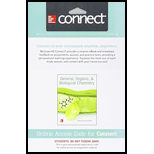
Concept explainers
(a)
Interpretation:
The hydroxyl groups, halogens, sulfhydryl groups and ether oxygen of each compound, chondrocohole A, 3-methyl-3-sulfanyl-1-hexanol, and salmeterol should be labeled.
Concept introduction:
A functional group is defined as a specific group of atoms or bonds within a compound and functional group is decided the chemical characteristic of the compound. The same
(b)
Interpretation:
The −OH that is not a part of alcohol should be labeled and need to explain the choice.
Concept introduction:
A functional group is defined as a specific group of atoms or bonds within a compound and functional group is decided the chemical characteristic of the compound. The same functional groups have same chemical properties, and undergoing same reactions. In organic chemistry, the most common functional groups are carbonyls (C=O), carboxylic acids (CO2H), alcohols (-OH), esters (CO2R), and amines (NH2).
Want to see the full answer?
Check out a sample textbook solution
Chapter 14 Solutions
Connect 1-Semester Access Card for General, Organic, & Biological Chemistry
- a. b. Question 2: Give IUPAC name for each compound. o & C. d. 1 e. f.arrow_forwardDraw the structure of a hydrocarbon that has six carbon atoms and a. three vinylic hydrogens and two allylic hydrogens. b. three vinylic hydrogens and one allylic hydrogen. c. three vinylic hydrogens and no allylic hydrogens.arrow_forward1. Provide the IUPAC name for each of the following organic molecules. a. b. C. H3C H3C, Home H3C CH3 CH3 CH3 Br H 2. Draw structures for the following organic molecules, using the wedged/hashed line convention to depict any stereochemical relationships between groups: a. cis-3-ethylcyclobutane-1-carbaldehyde b. (R)-1-chloro-6-iodo-6-methyloctan-3-onearrow_forward
- Chemistry organic chem question.arrow_forward6. Draw the following compounds. a. 2-pentanol b. ethylpropylamine c. methyl propyl ether d. butyl propyl ketone abayoqtheo ghidollo WHO H3--3 HO HO HO HO HOarrow_forwardFor the cation shown, four resonance structures are possible. Two resonance forms are given, but they are incomplete. Complete structures 1 and 2 by adding nonbonding electrons and formal charges. Complete the two remaining resonance structures according to their description, including nonbonding electrons and formal charges. Structure 1: add lone pairs and charges X H₂C H₂C CH3 CH₂ Structure 2: add lone pairs and charges H₂C H₂C 0- CH₂ CH₂arrow_forward
- Give the IUPAC name for each compound.arrow_forwardон C-H ÓR Compound that contains a group like that shown above. a. acetal Ob. aldehyde c. Benedict's reagent d. carbonyl Oe. hemiacetal Of. hemiketal Og. hydrolysis h. ketal i. ketone Oj. Tollen's reagent 2.arrow_forwardWhich among these have the highest boiling point? Rank them from A-D. Methanol, water, ethanol, and diethyl ether. Please explain thoroughly including each of their intermolecular forces and how it makes them stronger or weaker than the others.arrow_forward
- Give the IUPAC or common name for each compound.arrow_forwardexplain why is OH group in phenols more strongly held as compared to OH group in alcohols.arrow_forwardLabel each functional group as an alcohol, ether, acetal, or hemiacetal. LOCH3 a. OCH3 (select) OH b. CH3-C-OCH2CH,CH3 CH3 (select) с. `OCH,CH,CH3 (select) d. OCH,CH,CH3 (select) (select) two ethers hemiacetal acetal alcohol and ether alcohol etherarrow_forward
 Chemistry for Today: General, Organic, and Bioche...ChemistryISBN:9781305960060Author:Spencer L. Seager, Michael R. Slabaugh, Maren S. HansenPublisher:Cengage Learning
Chemistry for Today: General, Organic, and Bioche...ChemistryISBN:9781305960060Author:Spencer L. Seager, Michael R. Slabaugh, Maren S. HansenPublisher:Cengage Learning Chemistry: Principles and PracticeChemistryISBN:9780534420123Author:Daniel L. Reger, Scott R. Goode, David W. Ball, Edward MercerPublisher:Cengage Learning
Chemistry: Principles and PracticeChemistryISBN:9780534420123Author:Daniel L. Reger, Scott R. Goode, David W. Ball, Edward MercerPublisher:Cengage Learning Introductory Chemistry: An Active Learning Approa...ChemistryISBN:9781305079250Author:Mark S. Cracolice, Ed PetersPublisher:Cengage Learning
Introductory Chemistry: An Active Learning Approa...ChemistryISBN:9781305079250Author:Mark S. Cracolice, Ed PetersPublisher:Cengage Learning Organic Chemistry: A Guided InquiryChemistryISBN:9780618974122Author:Andrei StraumanisPublisher:Cengage Learning
Organic Chemistry: A Guided InquiryChemistryISBN:9780618974122Author:Andrei StraumanisPublisher:Cengage Learning



